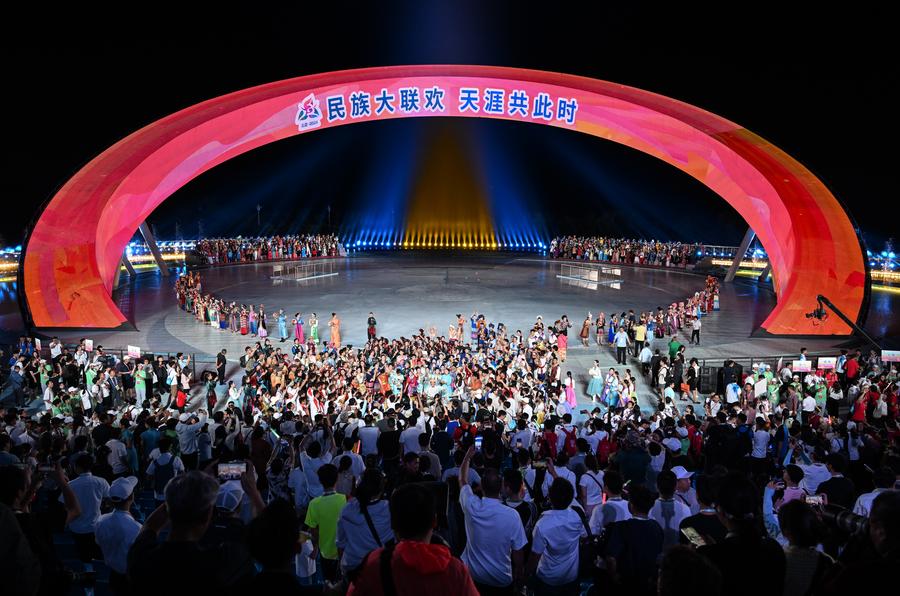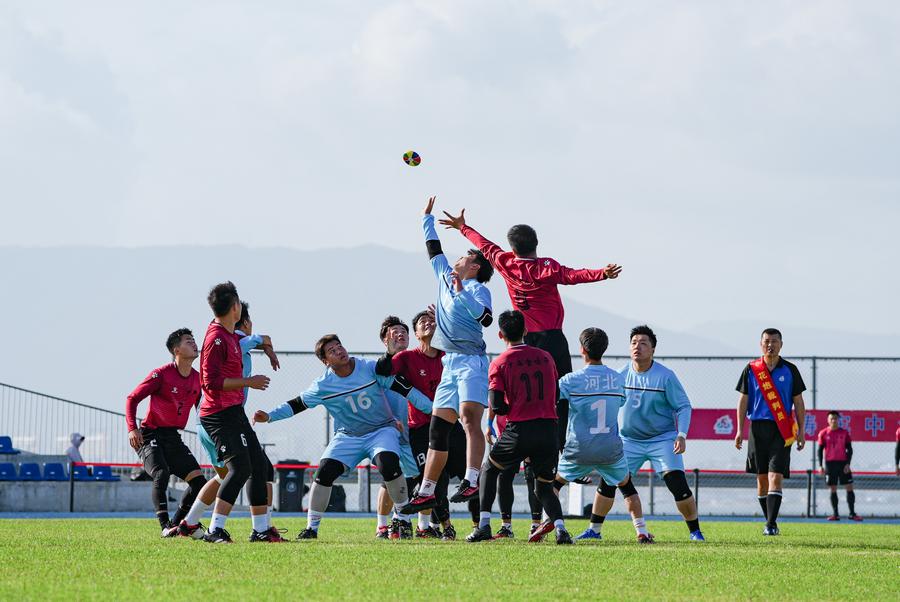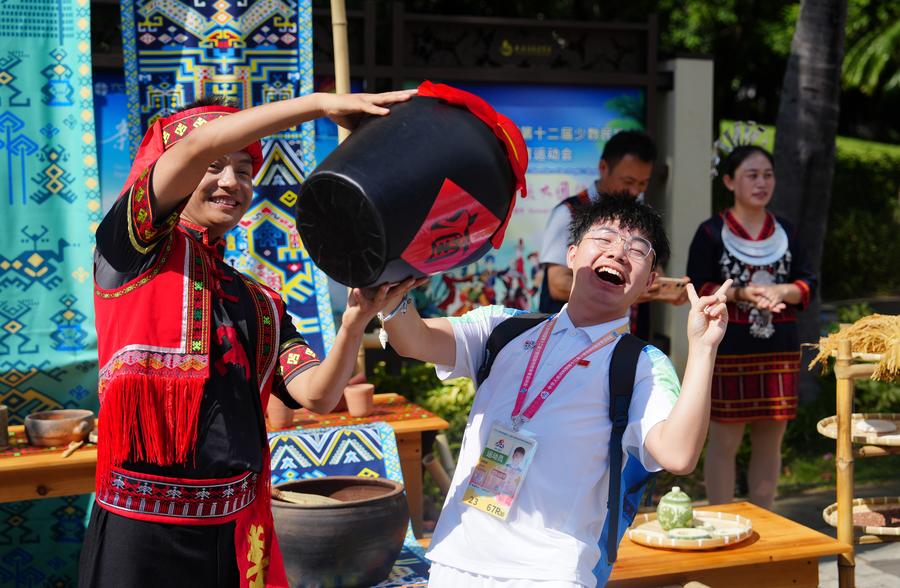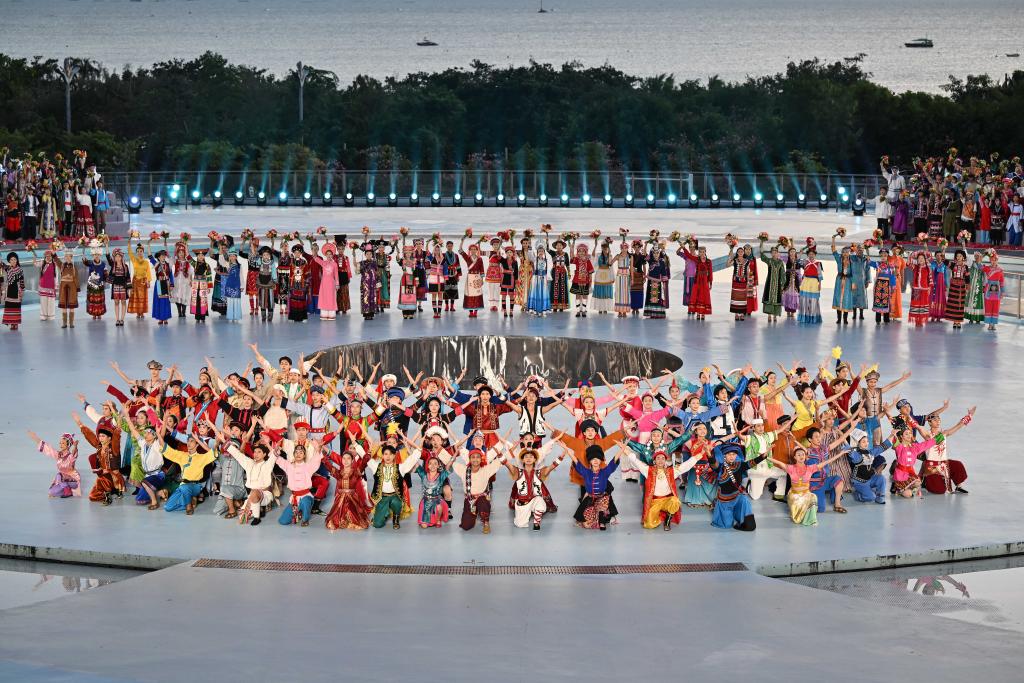新華社 2024-11-28 20:22:35

Artists celebrate with the audience at the end of a gala held at the 12th National Traditional Games of Ethnic Minorities of China in Sanya, south China's Hainan Province, Nov. 26, 2024. (Xinhua/Guo Cheng)
SANYA, China, Nov. 28 (Xinhua) -- China's 12th National Traditional Games of Ethnic Minorities is more than just a sports competition; it serves as a vivid expression of the unity and harmony of the country's 56 ethnic groups.
Traditional activities such as Huapao (sparkler-grabbing), pearl ball, and single bamboo drifting, which originated from specific ethnic groups or regions, have evolved into sports events with participation from multiple ethnicities, showcasing ethnic integration through spirited contests.

Players competes during the sparkler-grabbing game between Guangxi and Hebei at the 12th National Traditional Games of Ethnic Minorities of China in Sanya, south China's Hainan Province, Nov. 25, 2024. (Xinhua/Jinmeiduoji)
The newly introduced coconut tree climbing race is a prime example of this transformation. Originating from traditional practices in the host province of Hainan, the event brought together athletes from 11 different teams.
Lin Min, the leader of the Hainan team, expressed his excitement about the diversity of participants, believing that the competition allows athletes from different regions and ethnic backgrounds to exchange skills and learn from each other, ultimately helping Hainan's traditional event gain wider recognition.
Cao Jingwei, a tourist from Henan Province, was impressed by the competitors' skills and even more so by the sense of ethnic unity. "Hearing the announcer introduce athletes from so many ethnic groups, including Han people, gave me a strong sense of unity," she said, adding that the sports games are not just about competition but also serve as a meaningful event that brings everyone together as one big family.

A visitor poses with an artist during a performance gala of the 12th National Traditional Games of Ethnic Minorities of China in Sanya, south China's Hainan Province, Nov. 26, 2024. (Xinhua/Hu Chao)
The ethnic aerobics competition, with participation from 32 teams across the country, illustrates the growing diversity of these games.
Li Junyi, chief judge of the event, explained that although the routines last only a few minutes, they integrate elements from more than 20 ethnic groups dances, including Tibetan, Uygur, Mongolian, and Dai. Each participant, regardless of their ethnicity, learns and performs movements that come from other traditions, deepening their appreciation for diverse cultures. "This is the beauty of harmony and integration," Li noted.
Off the fields, athletes from different ethnicities shared stories of their cultures, embodying the spirit of "friendship first, competition second."
Yu Ping, a 51-year-old Mongolian shuttlecock player, is participating in the games for the fifth time.
"Playing shuttlecock has not only kept me fit but also given me opportunities to meet friends from various ethnic groups," she said.
"These cultural exchanges enrich the event and deepen understanding and friendships among different ethnic groups," Yu added.

Artists perform during a gala held at the 12th National Traditional Games of Ethnic Minorities of China in Sanya, south China's Hainan Province, Nov. 26, 2024. (Xinhua/Guo Cheng)
A gala celebrating the Games is another epitome of national unity.
Athletes and guests not only enjoyed vibrant performances of traditional songs and dances, but also exchanged gifts and came together to perform the Gongtong Dance of the Li ethnic group, inspired by the rhythms of Danzhou folk tunes.
"This interesting exchange activity allows us to experience different traditions and cultures. I truly feel that the Chinese nation is a united and diverse family," said Ji Yongjun, a Manchu dragon boat athlete from Beijing.
責(zé)編:唐煜斯
一審:唐煜斯
二審:秦慧英
三審:禹振華
來源:新華社
我要問



 下載APP
下載APP 報(bào)料
報(bào)料 關(guān)于
關(guān)于
 湘公網(wǎng)安備 43010502000374號(hào)
湘公網(wǎng)安備 43010502000374號(hào)